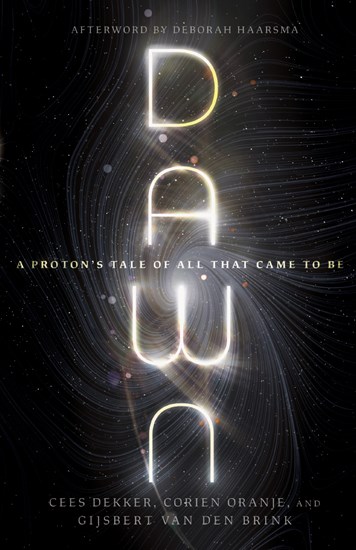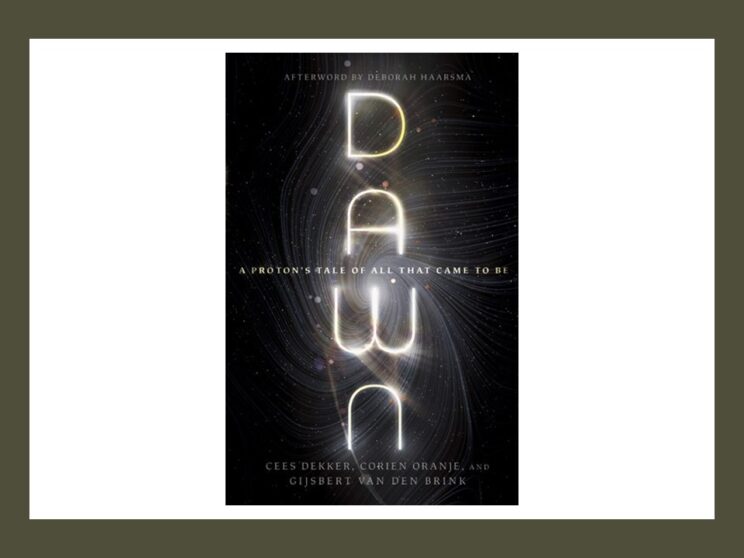
Stop me if you’ve heard this one: a biophysicist, a writer, a theologian walk into a bar. OK, so that’s not actually how Dawn was written, but the diverse backgrounds of the three co-writers–Cees Dekker, Corien Oranje, and Gijsbert van den Brink respectively–do sound more like résumés for the cast of a niche joke than for collaborators on a novel. And not just any novel, but one that spans 14 billion years–from the instants after the Big Bang until the moment the manuscript was sent to the printers (or so it seems, given the current events mentioned in Chapter 23, “Space”). As the subtitle “A Proton’s Tale of All that Came to Be” suggests, the protagonist of this novel is also unique; I’ve never read a book from the point of view of a subatomic particle before. (Talk about your unreliable narrators; subatomic particles make up everything!) So what does a proton have to say?
Pro, as his friends (mostly other protons and neutrons) call him, has existed since space and time began with the Big Bang and has witnessed the history of Earth since before it was Earth. He was part of the star where fusion formed the nuclei of the heavier elements like carbon before going supernova to make them available as the raw material for our solar system. Pro was incorporated into one of those carbon atoms, allowing him to be around for the origin of life. Thanks to the carbon cycle and the food chain, he would subsequently be a part of a variety of organisms, from microbes to dinosaurs to plants. Once humans start using plant materials as tools, he gets to be part of inanimate organic objects as well, like bamboo fences and wooden walking sticks.
Speaking of the arrival of humans, I was surprised how quickly they showed up. I didn’t expect an exactly proportional story; that would mean over 100 of the 150 pages would take place before Earth and life as we know it make an appearance, followed by 20ish pages of just microbes. Dry land wouldn’t get inhabited by plants and animals as we might recognize them until the last 5 pages, and humans would appear in the final sentence–with only the period at the end to represent all of written history. Instead, by page 50 we have caught up to the Biblical narrative. A proton’s-eye-view of events from the Bible from Genesis to Revelation will occupy the next 80+ pages, followed by a brief look in on the present.
If I’m honest, I was hoping for something in between those options. If the goal is to capture the grand sweep of God’s plan for the cosmos, I can appreciate why you’d want to include something about the story of Israel and the life of Jesus. At the same time, those are hardly unfamiliar events, particularly for Christians. With such a novel protoganist, I thought we’d get less of a human-centric take on creation. Obviously a book by humans can only go so far, and there’s little reason to believe protons actually have a subjective experience to understand. Still, Pro’s existence as part of a carbon atom creates opportunities to see the world as any number of organisms throughout time. We get a little bit of that, but both the commentary and the brevity cast it all as prelude to the arrival of humans.
Now, as a biologist I’m obviously not representative of general interest in non-human organisms. So my expectations may be skewed. There almost certainly is an audience for exactly what this book offers–an overview of the Bible (from a reformed theology perspective) with an extended description of creation incorporating the basics of Big Bang cosmology and evolutionary biology. If I had read this in high school or college, I could see it playing a similar role to Polkinghorne’s The Faith of a Physicist for me. I hope it finds the people who are at that point in their lives.
I’ll be chatting with the authors of Dawn— Cees Dekker, Corien Oranje, and Gijsbert van den Brink–tomorrow (October 13, 2022) at 12pm EDT. If you are seeing this beforehand, we’d love to have you join us. There will be an open Q&A if you want to ask the authors about the book, or you can listen to them answer the Qs I come up with.

Due to a technical error on my part, Julie Reynolds’ most recent post, Get Ready! It’s Brine Shrimp Season!, was incomplete for a few hours after it went live. If you didn’t see the whole thing then (or if you didn’t get a chance to read it at all), please check out the whole thing now.
Andy has worn many hats in his life. He knows this is a dreadfully clichéd notion, but since it is also literally true he uses it anyway. Among his current metaphorical hats: husband of one wife, father of two teenagers, reader of science fiction and science fact, enthusiast of contemporary symphonic music, and chief science officer. Previous metaphorical hats include: comp bio postdoc, molecular biology grad student, InterVarsity chapter president (that one came with a literal hat), music store clerk, house painter, and mosquito trapper. Among his more unique literal hats: British bobby, captain’s hats (of varying levels of authenticity) of several specific vessels, a deerstalker from 221B Baker St, and a railroad engineer’s cap. His monthly Science in Review is drawn from his weekly Science Corner posts — Wednesdays, 8am (Eastern) on the Emerging Scholars Network Blog. His book Faith across the Multiverse is available from Hendrickson.

Leave a Reply